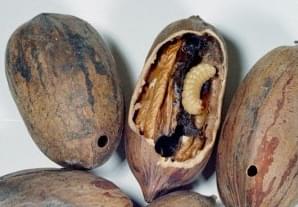As we enter into August, now is the time to start preparing for managing pecan weevils as they will soon be emerging from the ground and into your pecan trees. If you have already had pecans dropping prematurely out of your trees, it could very well be a sign that pecan weevils are now emerging from the ground. Pecan weevils typically emerge from the ground in August to September, often after a significant rainfall of 1” or more.
Many people run into a problem in the fall when harvesting pecans of discovering a white worm inside a pecan shell. By the time most people discovered the problem in fall and winter, it is too late to control. The pecan weevil is a pest to start controlling in August and September to prevent discovering problems later this year.
The pecan weevil causes two types of damage. The first type is when the adult weevils puncture the nuts in early August, causing the nuts to fall after two or three days. The adult pecan weevils are reddish-brown to gray beetles with long slender snouts and thin legs. The second type of damage is caused by larval feeding within the nut. The larva chews a circular hole through the shell, and, as nuts fall to the ground, it exits the nut, and burrows into the soil. Larvae are creamy white, legless grubs with reddish brown heads.
Understanding the life cycle of the pecan weevil helps explain why the weevils cause two types of damage. The adult weevils emerge from the soil from August through September. Often times they emerge from the soil when we have a significant rainfall of an inch or more. The majority of weevils fly to the tree trunk or tree canopy while a small number walk. After the female adult weevils puncture the nut in early August, the eggs are laid inside the developing pecan. At maturity the larvae exit the nut and burrow into the soil. They remain in the soil until the following August where they then pupate and emerge as adults. Then the cycle begins again with the adult weevils puncturing the pecan nuts.
Now that we know how those white larvae get into the pecan, the next questions is how to manage the pecan weevil. Because the adult weevils are emerging from the ground during August in search of pecans to puncture, this is the time you want to control them. You want to control the adult weevils as they are emerging from the ground because they cannot be reached once they are in the nut or while they are in the soil. The weevil’s emergence from the soil is during a two-month period of August to September, so monitoring for when the adults emerge from the soil is important. A simple way to monitor is by inspecting nuts that have dropped to the ground prematurely. Also keep in mind that the weevils usually emerge from the soil after a rainfall. A dry or hard soil provides a physical barrier to the adult weevils, delaying their emergence from the soil.
If you decide to use insecticide to control the pecan weevil, applications should be made every 7 days from mid-August through mid-September using a carbaryl (Sevin) insecticide. If you want to try avoiding using insecticides or want additional control along with the insecticide, a good control method is to gather and destroy weevil-infested nuts as they fall to prevent the larvae from entering in the ground and hanging around until next growing season.
If you prefer to not use insecticides, there is sticky paper traps (such as Tanglefoot and others) available. The paper goes around the tree once at a height greater than 6 feet and then a sticky paste is applied with a putty knife in a narrow band on the paper. The insects that crawl up the tree will become stuck to the paste. Do keep in mind that most pecan weevils fly into the tree, so the sticky paper traps will only catch and control the weevils that are crawling up the tree trunk. As with insecticides, apply this material beginning the first week of August and leave it on the tree through mid-September. Remove the tape after mid-September to prevent tree girdling over time. This material can be found at some local garden centers and online.
August through September is the time to be on the outlook for the pecan weevil. With an understanding of the pecan weevil’s life cycle and knowing when to watch for weevils emerging from the ground you may prevent the disappointment of cracking open pecan shells and finding a little worm enjoying your pecans instead of you.
Recommendations for the use of agricultural chemicals are included in this article as a convenience to the reader. The use of brand names and any mention or listing of commercial products or services in this article does not imply endorsement by North Carolina Cooperative Extension nor discrimination against similar products or services not mentioned. Individuals who use agricultural chemicals are responsible for ensuring that the intended use complies with current regulations and conforms to the product label. Be sure to obtain current information about usage regulations and examine a current product label before applying any chemical.
____
Jessica Strickland is an Agriculture Extension Agent, specializing in horticulture for North Carolina Cooperative Extension in Wayne County.

(Photo Credit: NC State Extension)

